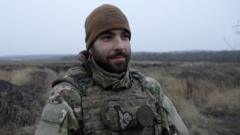Amidst discussions of possible talks to end the war, the perspectives of soldiers, civilians, and those who have fled the conflict reveal a stark consensus: the toll of the war has prompted calls for both continued resistance and the consideration of ceasefires, reflecting a nation torn between fighting for sovereignty and seeking peace.
The ongoing war has left many in Ukraine weary, questioning the future as they balance hope for peace with the harsh realities of combat.
In one area deep in conflict, Ukrainian forces continue to face mounting pressure from Russian troops, especially around Kurakhove. Soldiers from a unique unit known as the Black Pack are focused on staving off encirclement while reflecting on their personal journeys and the overarching war. The members include a variety of professionals from a vegan chef to an artist, bound by their commitment to resist Russian aggression.
Surt, the unit's commander, has had a somber realization about the war's duration, shifting his mindset from expecting a three-year conflict to preparing mentally for a decade-long struggle. Despite knowing that Russia, alongside potential negotiators like Donald Trump, could be open to discussions, he remains skeptical about achieving any meaningful resolution, wary of the sacrifices that may accompany peace talks.
The sentiment among many in the unit leans toward continuing the fight, with arguments about the futility of temporary agreements. Serhiy, the vegan chef, suggests that any ceasefire could simply postpone further violence, while Davyd, an artist, expresses unease about the unpredictability of political figures involved in negotiations.
While some soldiers find solace in their weekly training routines during rest periods, others share grave concerns about the high costs of war, particularly Denys, who recently joined from Germany. He argues for a reevaluation of the military strategy, claiming that a significant number of motivated soldiers are either lost or exhausted.
Beyond the battlefield, civilians like Ludmyla and Kseniia in Dnipro express grave worries about the war's toll on their country and its people. Despite the air-raid sirens and constant threat of missile attacks, they seek a semblance of normalcy in life, grappling with a longing for peace. As opinions shift toward a desire for negotiations, the voices of displaced individuals resonate strongly, emphasizing the pressing need for dialogue to achieve lasting peace.
In their refuge from the conflict, elderly women recount the anguish of leaving their homes, a stark reminder of the personal costs of warfare. Their desire for peace aligns with an understanding that military victories will come with sacrifices, leaving them uncertain about the future ramifications of potential agreements.
As Ukraine faces another year of war, the narratives of both soldiers and civilians intertwine, underscoring the complex calculus of survival, resistance, and the longing for peace in an environment marked by devastation.
The ongoing war has left many in Ukraine weary, questioning the future as they balance hope for peace with the harsh realities of combat.
In one area deep in conflict, Ukrainian forces continue to face mounting pressure from Russian troops, especially around Kurakhove. Soldiers from a unique unit known as the Black Pack are focused on staving off encirclement while reflecting on their personal journeys and the overarching war. The members include a variety of professionals from a vegan chef to an artist, bound by their commitment to resist Russian aggression.
Surt, the unit's commander, has had a somber realization about the war's duration, shifting his mindset from expecting a three-year conflict to preparing mentally for a decade-long struggle. Despite knowing that Russia, alongside potential negotiators like Donald Trump, could be open to discussions, he remains skeptical about achieving any meaningful resolution, wary of the sacrifices that may accompany peace talks.
The sentiment among many in the unit leans toward continuing the fight, with arguments about the futility of temporary agreements. Serhiy, the vegan chef, suggests that any ceasefire could simply postpone further violence, while Davyd, an artist, expresses unease about the unpredictability of political figures involved in negotiations.
While some soldiers find solace in their weekly training routines during rest periods, others share grave concerns about the high costs of war, particularly Denys, who recently joined from Germany. He argues for a reevaluation of the military strategy, claiming that a significant number of motivated soldiers are either lost or exhausted.
Beyond the battlefield, civilians like Ludmyla and Kseniia in Dnipro express grave worries about the war's toll on their country and its people. Despite the air-raid sirens and constant threat of missile attacks, they seek a semblance of normalcy in life, grappling with a longing for peace. As opinions shift toward a desire for negotiations, the voices of displaced individuals resonate strongly, emphasizing the pressing need for dialogue to achieve lasting peace.
In their refuge from the conflict, elderly women recount the anguish of leaving their homes, a stark reminder of the personal costs of warfare. Their desire for peace aligns with an understanding that military victories will come with sacrifices, leaving them uncertain about the future ramifications of potential agreements.
As Ukraine faces another year of war, the narratives of both soldiers and civilians intertwine, underscoring the complex calculus of survival, resistance, and the longing for peace in an environment marked by devastation.



















